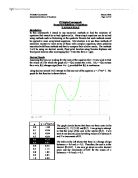This can be written as [2.392149, 2.392150]
Another way of writing the error bounds is that assuming the root lies exactly in-between the two bounds (midpoint).
- Firstly finding the midpoint of the two gives: 2.3921495
- Then taking the lower bound away from the midpoint gives 0.0000005
-
Therefore you can write α= 2.3921495 ± 0.0000005
Therefore you can write α= 2.392145 (6s.f.)
Or using the error formula: Error = X – x
α= 2.3921495 the error in this approximation is 5.0x107
When change of sign does not work
If I translate my curve that I have used in the last part vertically 4 units, I get the new equation:
y=x³–5.5x²+2x+17
As you can see from the graph there is a local minimum between x=3 and x=4. When the method of Decimal search is used with graphs of this nature it is not possible to see the change of sign when it is initially done with integer values, as shown in the table below for this equation.
To show another limitation I have used the equation: y=x²–4.6x+5.29
Decimal search does not work with repeated roots because the integer values either side of the root are the same sign.
To show another limitation of The Decimal search method I have used the equation:
As you can see from the table below, there must be a sign change between x=3 and x=4, however looking at the graph shows that there is actually a discontinuity.
Newton-Raphson Method
xr+1 = xr – f (xr)
f ’(xr)
y= 4ln|x| - x + 2
dy= -1 + 4
dx
Error Bounds
x= 0.727514 ± 0.0000005
f(0.7275145) = 4xln0.7275145-0.7275145+2
= 1.04545x10-07 >0
f(0.7275135) = 4xln0.7275135-0.7275135+2
= -4.39363 x10-06 <0
When the bounds are put into the formula, they show a change of sign which means that there is a root between the two intervals, therefore confirming that:
α= 0.727514 ± 0.0000005.
Therefore:
α= 0.727514 (6s.f.)
When Newton-Raphson does not work
y= 20x5– 3x2 + 0.1
dy= 100x4-6x
dx
x0= 0
x1= 0-(20x05-3x02+0.1)
100x04-6x0
x1= 0-0.1
0
Cannot divide by 0.
Fixed Point Iteration
My Function is:
Comparison of the Methods
Newton-Raphson
Newton-Raphson is the quickest to converge with 5 iterations, there are a relatively large amount of calculations that have to be done however. Differentiating is difficult for computers to do however because of the different rules involved, for example products, quotients, and trigonometric functions. If you can differentiate it is possible to find the root very easily with scientific calculators, the same sort of method as described below can also be used on spreadsheet programs.
On my calculator these are the steps used to set it up:
Fixed Point Iteration
Fixed point iteration converges quite quickly, taking 14 iterations. The mathematics is easier than involved in Newton-Raphson, the only difficult mathematics involved is the rearrangement of the equation. Like Newton-Raphson it is easy to set up on scientific calculators. The methods only downfall is that if f ‘(x) is too large or too small it will not work.
On my calculator these are the steps used to set it up:
Decimal Search
Decimal search takes the longest to converge with 41 iterations, however the method contains the easiest calculations. Decimal search is a bit more difficult to set up on calculators than the other two methods. Graphical calculators with a table function are probably the easiest to set up. If a calculator with a table function is not available the values would need to be written down to keep track of the calculations. With a good knowledge of a spreadsheet program such as Microsoft Excel and using IF and THEN statements, would take the human error out, and speed up the process. The main problems with Decimal search is that the process stops when one sign change is found, therefore other roots are missed, and when the root is repeated or just goes through the axis but comes back out before the next increment.
On my calculator these are the steps used to set it up:







